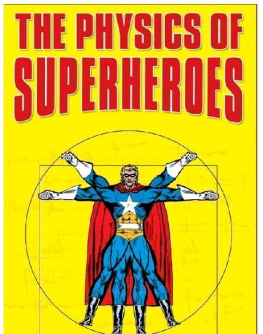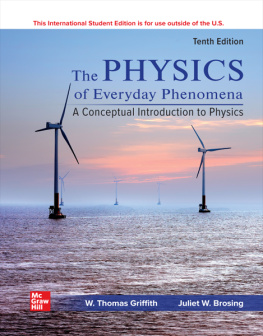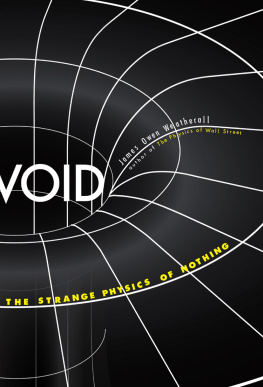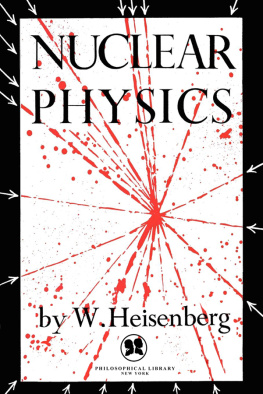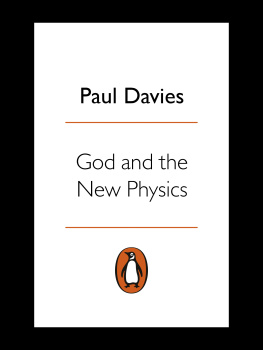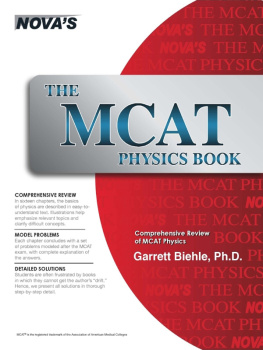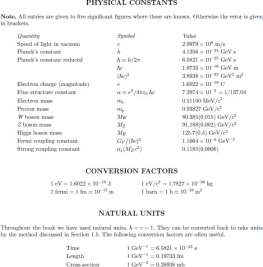To Therese
Foreword
While Wile E. Coyote is by no stretch of the imagination a superhero, I have to admit that it was this hapless villainwho escaped almost certain death episode after episode while continuing to fruitlessly chase the Road Runner with almost Sisyphean intensity day in and day outwho first got me thinking about the physics of illustrated characters. Even as a relatively young boy hooked on television, I suspected there was something fishy whenever I saw Wile E. run off a cliff and hover indefinitely until the moment he realized there was no solid ground underneath. Somehow it seemed to me even then that gravity should continue to work, whether or not one was conscious of it. I bring this example up, in spite of the fact that it involves no superheroes, and in fact involves a television cartoon rather than a comic book figure, because it illustrates a point that has become central to the way I think about teaching physics: Few things are more memorable than confronting ones own misconceptions. Indeed, some among those of us who study physics education for a living suggest that it is only by directly encouraging students to run up against their own misconceptions that one can hope to truly cause them to internalize what one is teaching them. I dont know whether this is true or not, but I do know that if you want to reach out to understand popular misconceptions, then exploiting where we get our cultural perspectives from is a good place to start. And if that means borrowing from Superman , or Star Trek , I am all for it!
Now, I dont want you to think that I bring up comic books and popular misconceptions in the same paragraph because I want to denigrate the former. Far from it! Indeed, the comics sometimes actually get it right, and as James Kakalios describes in his introduction to this far-reaching journey from the gravity of Krypton to the quantum mechanics of the X-Men, students often seem to grumble about how the standard examples from his introductory physics class have nothing to do with the real world they will encounter upon graduation. But when they are instead introduced to the physics of superheroes, this complaint never arises!
One might initially wonder whether Superman might seem more real to students than pulleys, ropes, and inclined planes. But the real reason students dont complain is undoubtedly that the comic book examples are fun , while inclined planes arent. And that is perhaps one of the most useful reasons for thinking about the physics of superheroes. Not only can you imagine, and be introduced to, lots of interesting physics, from everyday phenomena to esoteric modern subjects, but it is actually fun to think about. Moreover, while subjects like Quantum Mechanics might seem intimidating, who could be intimidated by cute Kitty Pryde?
Some who remember the comic books that enthralled them as young people might also recall a sense of wistfulness in pondering whether our own world could ever capture the excitement and drama of the worlds of comic book superheroes. In truth, however, it is far more interesting and exciting, if only we open up our minds to the hidden wonders of nature that science has revealed to us over the past four hundred or so years. Truth is far stranger than fiction, even comic book fiction. And finding out why is all part of the fun.
Lawrence M. Krauss
Cleveland, Ohio, April 2005
Preface
I was a comic-book fan as a kid, but like many of those who have come before and after me, I abandoned the hobby in high school upon discovering girls. My mother, following the standard script, used this opportunity to throw my collection away. I renewed my comic-book-reading habit years later, in graduate school, as a way to relieve the stress of working on my dissertation. Now as an adult Ive rebuilt much of my comic-book collection (or, as my wife refers to it, the fire hazard), but to be safe, my mother is not allowed near it.
Back in 1998 the University of Minnesota, where I am a physics professor, introduced a new type of class termed freshman seminars. These are small, seminar-type classes open to entering students, and while they are for college credit, they are not tied to any particular curriculum. Professors are encouraged to develop classes on unconventional topics, and freshman seminars on Bio-Ethics and the Human Genome; The Color Red (a chemistry class); Trade and the Global Economy; and Complex Systems: From Sandpiles to Wall Street, are among the many classes offered. In 2001 I introduced a class originally entitled Everything I Know About Science I Learned from Reading Comic Books. This is an actual physics class, treating most of the topics traditionally covered, but rather than employing illustrations of masses on springs, or blocks sliding down inclined planes, all of the examples came from the four-color adventures of costumed superheroes, and focused in particular on those situations where the comic books got their physics right.
The present book, while inspired by this class, is not a textbook per se. It is written for the nonspecialist who is interested in a relatively pain-free way to learn about the basic physics concepts underlying our modern technological lifestyle. Topics such as forces and motion, conservation of energy, thermodynamics, electricity and magnetism, quantum mechanics, and solid-state physics are discussed, and real-world applications such as automobile airbags, transistors, and microwave ovens are explained. I hope you will be so busy enjoying this superhero ice cream sundae that you wont realize that I am sneakily getting you to eat your spinach at the same time.
This book is intended for both longtime comic-book fans and those who cant tell Batman from Man-Bat. I have therefore described the history and background of the comic-book heroes discussed here. In order to describe the physics connected with certain superheroes or story lines, I have had to summarize key plot points in various comic books. Therefore, for those who have not yet read these classics, the following two words apply to this entire book: Spoiler Alert.
Readers interested in consulting the source materials considered here will find citations to the comic books discussed in the text at the end of the book. I have listed the original comic-book information and, whenever possible, where the issue can be found in a recent reprint volume at bookstores and comic shops. The dates listed for a given comic book, printed on its cover, are not when the issue first appeared on the newsstands. To extend shelf life, the date listed indicated when the comic was to be returned to the publisher for credit, and not when it became available for purchase. In an effort to attract new readers who desire first issues as collectors items, comic books will occasionally restart their numbering scheme while keeping the name of the comic unchanged. If not otherwise noted, issue numbers refer to the first volume of a comic. I have listed, where known, the writer and artist for each comic listed in the endnotes. My omission of the inkers should not be construed as denigrating their contribution to the finished comic (I most certainly do not believe that such a job is equivalent to tracing), but rather a reflection of the fact that the artist along with the writer typically have the primary responsibility for the physics in a given comic book scene. Any discussion of physics in comic books naturally invites the scrutiny of physicists as well as comic-book fans, both of who are known for their... attention to detail. Each of the incidents I selected happened to illustrate a particular physics principle. Sometimes the very next issue would contain a scene contradicting the physically plausible manifestation of a superpower described here. When considering characters that have starred in multiple comic books for over half a century, it is a sure bet that there will be counter-examples for any statement I make. Consequently, while examining the physics associated with a superheros powers will, in many cases, provide a better appreciation for their talents, my comrades in fandom are advised that this book is not intended to provide definitive accounts of any characters power or adventures. Similarly, my physics colleagues are warned that this book is for a non-expert audience. I have attempted to keep things simple, while acknowledging the rough edges and complications of the real world. A complete discussion of many of the topics considered here could easily expand to fill several volumes and would provide a concrete illustration of Dr. Manhattans final words at the conclusion of Alan Moores and Dave Gibbons Watchmen :
Next page
